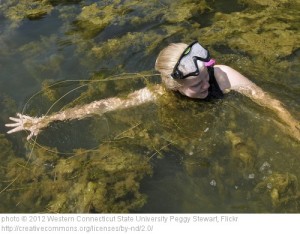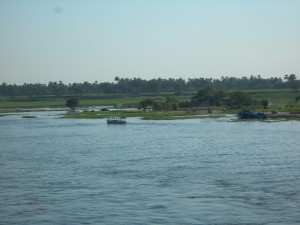Over the past week, I started looking into invasive aquatic plants, focusing largely on which species seem most worrisome, how they are being moved around, and how they may impact the ecosystems they invade. After a little searching, I started to see patterns with regard to names and means of transport, but I also started to see different interpretations of invasive species ecosystem roles, which suggests that there is still a lot to learn about this vegetation. What was clear is that this is a global issue, both in terms of source populations and destinations.
What species are the worst offenders? That’s a pretty complicated question since it requires defining what a ‘significant impact’ is, as well as categorizing good and bad. Additionally, these invasive species all came from some place, so they are native flora in someone’s backyard. However, there were a few names that kept coming up again and again in variety of places: Spartina alterniflora (a type of marsh grass), Caulerpa taxifolia (popular in aquaria), Hydrilla verticillata, Eichhornia crassipes (water hyacinth), Ipomoea aquatic (Chinese water spinach), Myriophyllum spicatum (European milfoil). Records for these species as invaders span the globe and a variety of water habitats. Some are an issue in coastal wetlands and in marine ecosystems (like Spartina and Caulerpa) while others are found in freshwater systems. The US, IUCN, other countries, and individual states have lists of invasive vegetation in case you want to see what’s a real issue where you are (and what you’re not supposed to be growing…)- what was very interesting to me was looking through the US Federal List of Noxious Weeds and then searching the internet for vendors- some of these are unnervingly easy to find and don’t mention their status as invasives (in fact, I found detailed instructions on how to take very good care of water hyacinth).
Exactly what is it that makes them so scary? Well, it depends on the species, but some of them have the real capacity to modify the environments around them, and that can be a problem for native flora and fauna, as well as for humans. Water hyacinth and hydilla are on Florida’s list of “most invasive” plants because they tend to reduce surface water flow and dissolved oxygen in the water, so they cause more sediment to settle which can fill channels and canals, and hydrilla can outcompete native eelgrass and alter the vegetation available to native fish and invertebrates (Gordon 1998). Milfoil was found to suppress and displace native plants from deeper water in New York’s Finger Lakes region (Madsen et al. 2008) and was linked to loss of habitat for larger fish in lakes in California and Nevada (Eiswerth et al. 2000). Spartina can trap sediment, changing west coast mud flats to raised marshes, and yet there are real concerns along the east coast about loss of native spartina as phragmites reeds spread. So, even the location is important to determining invader impact. And lest you think that the invasions are in one direction, in China fanwort from eastern North America is a problem (Zhang et al. 2003), and the Senegal delta in Africa has seen changes in water flow, sedimentation, and fauna with the presence of water hyacinth, water spinach, and other invasives (Fall et al. 2004). Having said all of this, there is still debate about whether invasive species are automatically bad and whether they can suitably fill ecosystem roles in their new habitat (Capers et al. 2007; Madsen et al. 2008; Mueller & Hellmann 2008). In some areas, invasives create a monoculture which negatively impacts native flora and fauna, in others invasives improve water quality. And how do you address an invasive which may be threatened in its native range? These situations can get pretty complicated.
How are these aquatic invaders moving around? We can take a lot of credit for this- we’re doing a pretty good job of providing transportation. In some cases, we’ve deliberately introduced nonnative species, such as the tomatoes which are now such a staple of Italian cooking (and originally from the Americas) or the chickens whose eggs I used for baking a few days ago (origin in southeast Asia) and sometimes these species get out from under our control- in the case of aquatic plants, that could be as a result of spreading aquaculture or even heavy rains which caused your pond to overflow into a nearby stream. We’ve also carried species unintentionally during the course of international trade, for example in the dirt and water ballasts of ships (which is one reason to have ships discharge ballast water mid-ocean and then take on fresh water for the remainder of the journey, although it’s not a complete solution), or even on planes (brown tree snake meet vulnerable Guam bird species, Guam bird species meet bad news…). And then there at the introductions done intentionally but without really thinking about it– Caulerpa and other species found in home aquaria tend to be released into the wild when people get tired of caring for pet fish and decide to liberate them- since the individuals in aquaria are more likely to be larger, mature specimens with the capacity for reproduction, versus those in ballast water, they already have a head start (Padilla & Williams 2004).
So we know that there are a variety of invasive species which are turning up in aquatic habitats across the globe, sometimes with very negative consequences for both native species and people (before control efforts, water hyacinth was using 10% of the Nile’s water (Padilla & Williams 2004)- that’s a pretty big deal). And we are largely responsible, whether we mean to or not, for the access these invasives have to new opportunities. For my next post, I’ll try to get a handle on how we’re trying to control and/or remove invasives and what concerns there are for the future given climate change predictions. My guess is it’s bound to get even messier.
Works cited:
Capers, RS, Selsky, R, Bugbee, GJ and JC White. 2007. Aquatic plant community invisibility and scale-dependent patterns in native and invasive species richness. Ecology 88: 3135-3143.
Eiswerth, ME, Donaldson, SG, and WS Johnson. 2000. Potential environmental impacts and economic damages of Eurasian watermilfoil (Myriophyllum spicatum) in western Nevada and northeastern California. Weed Technology 14: 511-518.
Fall, O, Fall, I and N Hori. 2004. Assessment of the abundance and distribution of the aquatic plants and their impacts in the Senegal River delta: the case of Khouma and Djoudj streams. Weed Technology 18: 1203-1209.
Gordon, DR. 1998. Effects of invasive, non-indigenous plant species on ecosystem processes: lessons from Florida. Ecological Applications 8: 975-989.
Madsen, JD, Stewart, RM, Getsinger, KD, Johnson, RL, and RM Wersal. 2008. Aquatic plant communities in Waneta Lake and Lamoka Lake, New York. Northeastern Naturalist 15: 97-110.
Mueller, JM and JJ Hellmann. 2008. An assessment of invasion risk from assisted migration. Conservation Biology 22: 562-567.
Padilla, DK and SL Williams. 2004. Beyond ballast water: aquarium and ornamental trades as sources of invasive species in aquatic ecosystems. Frontiers in Ecology and the Environment 2: 131-138.
Zhang, X, Zhong, Y and J Chen. 2003. Fanwort in eastern China: an invasive aquatic plant and potential ecological consequences. Ambio 32: 158-159.


